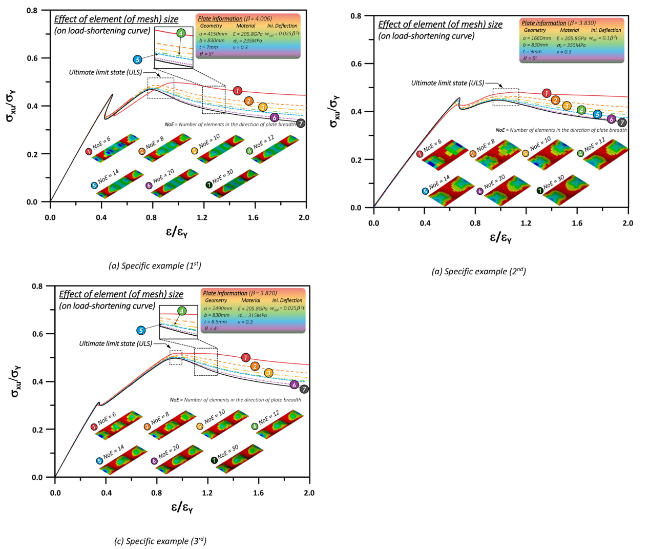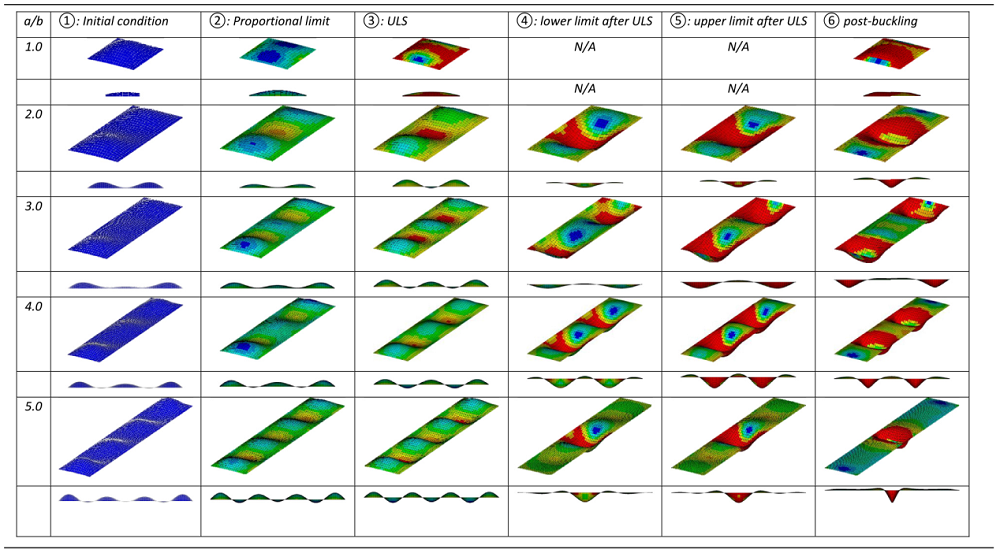1. Introduction
Fig. 1. How to allocate the number of elements in the plate by meshing? |
Table 1. Typical examples of initial deflection shape of flat- and curved plates (Note: Scale varies). |
 |
2. Research procedure
Fig. 2. Schematic view of to define flat- and curved plates. |
2.1. Consideration of mesh-size
2.1.1. Shape of the initial deflected plates: flat and curved
2.2. Generation of input data for ultimate strength calculation of numerical simulation
2.2.1. Material properties (Yield strength)
2.2.2. Plate geometry
2.2.3. Flank angle
2.3. FE modelling by ANSYS nonlinear finite-element method (NLFEM)
2.3.1. Mesh-size (or element number in plate's breadth direction)
Fig. 4. Examples of the considered number of elements (or mesh-size) in plate's breadth direction (Typical scenarios with a/b = 3). |
2.3.2. Boundary condition
Fig. 5. Boundary condition adopted in the FE model of flat- and curved plates. |
2.3.3. Applied loading
2.4. Expected outcome: ultimate strength performance of the plate
Fig. 6. Typical results of ultimate strength calculation by ANSYS nonlinear finite-element method (NLFEM). |
2.5. Verification of the FE technique
Table 2. Selected sample scenario from Park et al [42]. for the validation of the FE modelling technique. |
| Comparison case selected from Park et al. (2018): Page 12 | Geometric properties | Material properties | Design parameters | |||||
|---|---|---|---|---|---|---|---|---|
| a (mm) | b (mm) | t (mm) | wopl (mm) | θ (o) | σY (MPa) | E (GPa) | β | |
| 5,000 | 1,000 | 15 | 0.15 | 5 | 352.8 | 205.8 | 2.7603 | |
Note: a = plate length, b = plate breadth, t = plate thickness, wopl= initial deflection of the plate, θ= flank angle, σY= yield strength, E = elastic modulus (= Young's modulus), β= plate slenderness ratio (=(b/t) $ \sqrt{\sigma_{Y} / E}$). |
Fig. 7. Comparison of load-shortening curves of the curved plate between Park et al [42] and the present study. |
3. FE analysis results and discussions
3.1. Stress distribution, strain energy and ultimate limit state (ULS)
Table 3a. von-Mises stress views at ULS for typical plate (flank angle = 30, beta = 1.002). |
 |
Note: NoE = Number of elements in the direction of plate breadth. |
Fig. 8. Typical examples of the considered number of elements (NoE or mesh-size) in the plate's breadth direction (Flank angle = 30o, β= 1.002). |
Table 3b. von-Mises stress views at ULS for typical plate (flank angle = 30, beta = 2.003). |
 |
Note: NoE = Number of elements in the direction of plate breadth. |
Table 3c. von-Mises stress views at ULS for typical plate (flank angle = 30, beta = 3.506). |
 |
Note: NoE = Number of elements in the direction of plate breadth. |
Fig. 9. Typical examples of the considered number of elements (NoE or mesh-size) in the plate's breadth direction (Flank angle = 30o, β= 2.003). |
Fig. 10. Typical examples of the considered number of elements (NoE or mesh-size) in the plate's breadth direction (Flank angle = 30o, β= 3.506). |
3.2. Effect of flank angle, plate aspect ratio, and plate slenderness ratio
3.2.1. Reminder of the assumed condition and selected scenarios for outcome analysis
Table 4. Comparison of ULS results considering mesh-size effect. |
 |
Note: R1 to R3 represent row 1 to row 3, C1 to C5 represent column 1 to column 5. |
3.2.2. Effect of slenderness ratio (β)
3.2.3. Effect of plate aspect ratio (a/b)
3.2.4. Effect of flank angle (θ)
3.3. Additional investigation on the effect of mesh-size at specific conditions
Fig. 11. The effect of NoE on the load-shortening curves of the curved plate at specific conditions (i.e., lower flank angle with curved plate which generates snap-back, snap-through, secondary buckling etc.) |














